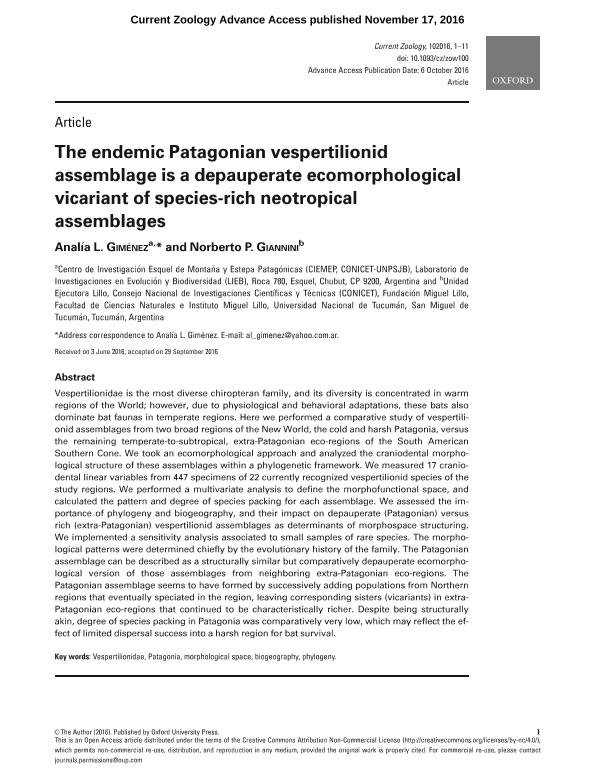Artículo
The endemic Patagonian vespertilionid assemblage is a depauperate ecomorphological vicariant of species-rich neotropical assemblages
Fecha de publicación:
10/2017
Editorial:
Oxford University Press
Revista:
Current Zoology
ISSN:
1674-5507
Idioma:
Inglés
Tipo de recurso:
Artículo publicado
Clasificación temática:
Resumen
Vespertilionidae is the most diverse chiropteran family, and its diversity is concentrated in warm regions of the World; however, due to physiological and behavioral adaptations, these bats also dominate bat faunas in temperate regions. Here we performed a comparative study of vespertilionid assemblages from two broad regions of the New World, the cold and harsh Patagonia, versus the remaining temperate-to-subtropical, extra-Patagonian eco-regions of the South American Southern Cone. We took an ecomorphological approach and analyzed the craniodental morphological structure of these assemblages within a phylogenetic framework. We measured 17 craniodental linear variables from 447 specimens of 22 currently recognized vespertilionid species of the study regions. We performed a multivariate analysis to define the morphofunctional space, and calculated the pattern and degree of species packing for each assemblage. We assessed the importance of phylogeny and biogeography, and their impact on depauperate (Patagonian) versus rich (extra-Patagonian) vespertilionid assemblages as determinants of morphospace structuring. We implemented a sensitivity analysis associated to small samples of rare species. The morphological patterns were determined chiefly by the evolutionary history of the family. The Patagonian assemblage can be described as a structurally similar but comparatively depauperate ecomorphological version of those assemblages from neighboring extra-Patagonian eco-regions. The Patagonian assemblage seems to have formed by successively adding populations from Northern regions that eventually speciated in the region, leaving corresponding sisters (vicariants) in extra- Patagonian eco-regions that continued to be characteristically richer. Despite being structurally akin, degree of species packing in Patagonia was comparatively very low, which may reflect the effect of limited dispersal success into a harsh region for bat survival.
Palabras clave:
Biogeography
,
Morphological Space
,
Patagonia
,
Phylogeny
,
Vespertilionidae
Archivos asociados
Licencia
Identificadores
Colecciones
Articulos(CIEMEP)
Articulos de CENTRO DE INVESTIGACION ESQUEL DE MONTAÑA Y ESTEPA PATAGONICA
Articulos de CENTRO DE INVESTIGACION ESQUEL DE MONTAÑA Y ESTEPA PATAGONICA
Citación
Giménez, Analía Laura; Giannini, Norberto Pedro; The endemic Patagonian vespertilionid assemblage is a depauperate ecomorphological vicariant of species-rich neotropical assemblages; Oxford University Press; Current Zoology; 63; 5; 10-2017; 495-505
Compartir
Altmétricas




